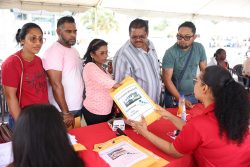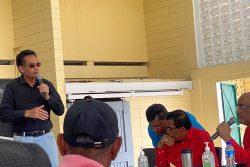Nearly everyone knows the eucalyptus, the clove, the Australian bottle brush, the myrtle and the guava. These and about 3,800 other species belong to the great family of plants comprising the Myrtaceae. Also included in this very large family is the Suriname cherry: Eugenia uniflora. Now the Suriname cherry has many virtues, not least of which is its value as a fresh fruit. It is widely planted as a single shrub throughout the West Indies and also as a hedging plant. Its few disadvantages include the fact that there is quite a lot of variability in the seedlings when it comes to fruiting. In other words it’s a bit of a lottery whether you get a bush that bears heavily or lightly. Of course it doesn’t matter too much if one is using dozens and dozens in a hedge, because some are bound to be good. Used singly, however, it’s a good idea to plant two or three either in pots or in the garden, and wait for a year or so until it is clear which is going to be the best. Then cut the others out.

I didn’t know until recently that the crushed leaves (rubbed onto the skin) could be used as an insect repellent.
When you first plant a cherry tree it is quite important to give it a good start nutritionally; that is to prepare the ground properly by cultivation, working in plenty of compost and keeping the young plants well supplied with water. As they become established, cover the ground around them with a good mulch to prevent loss of water, and make sure that weeds are not allowed to take hold. For the first few months it’s a good idea to feed the plants regularly. However, once you can see that they have become well established with plenty of young green healthy shoots, then ease up on the fertilizer.
Always remember that too much nitrogen on plants like the Suriname cherry and Barbados cherry will produce leaves at the expense of berries. That is alright while you are forming the main frame of the plant, but after that keep them short of it, otherwise you’ll get plenty of leaves and fruit production will be reduced. The exception is after plants have been heavily pruned, as my roses have just been. Here a plant will respond to nitrogen by producing new shoots and leaves. Apropos of this, try using a 45-gallon drum full of liquid fertilizer produced by filling it with water and immersing a bag of cow mould in it. The result looks like weak tea, and then apply it regularly to most of the plants which you might grow in pots.
Wounding
Some of you may have found certain plants difficult to root from hardwood cuttings. This can often be corrected by a technique called ‘wounding.’ This involves drawing the tip of a knife blade quite firmly down the last inch of a cutting making an incision through its skin. A more severe incision can be made a sixteenth of an inch wide and an inch down the last inch of the cutting with a knife. This stimulates the production of new roots by the cambium layer of cells found just below the ‘skin’ of cuttings. Used in combination with a hormone rooting powder this should produce good results.
Meanwhile take care of yourselves and may your God go with you.









